Tag Archive: research
March 8, 2018
by Carole Zangari -
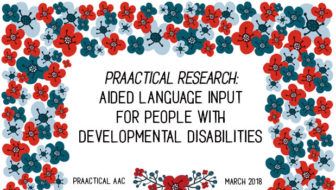
We’re pleased to welcome back Dr. Kathy Howery for another analysis of an AAC research article. Kathy is based in Alberta, Canada, and has worked in the field of AT and special education for over three decades. In the past year, she completed her doctoral studies where she used phenomenological methods to seek to understand the lived experience of speaking with/through a speech generating device. Kathy is currently working as a consultant to schools and school districts across Alberta focusing primarily on children and youth with complex communication needs. ::::::::::::::::::::::::::::::::::::::::::::::::::::::; Allen, A. A., Schlosser, R. W., Brock, K. L., & Shane, H. C. (2017). The effectiveness of aided augmented input techniques for persons with developmental disabilities: A systematic review. Augmentative and Alternative Communication, 33, 149-159. What this Article is All About (The Focus of the Research) This article presents the results of a systematic review of the research into what the authors refer... [Read More...]
Filed under: Featured Posts, PrAACtical Thinking
Tagged With: aided language input, augmented input, Kathy Howery, research
February 19, 2018
by Carole Zangari -

Today we are excited to share a wonderful collection of articles that help to expand the theoretical underpinnings and empirical knowledge base in AAC. The Augmentative and Alternative Communication journal is providing free access to six articles that are part of an ongoing international collaboration of researchers and clinicians in 16 nations. You can access articles from this project, entitled “Becoming an Aided Communicator: Aided Language Skills in Children aged 5–15 years: A Multi-site and Cross-cultural Investigation,” below. Kudos to the International Society for Augmentative and Alternative Communication (ISAAC) and the journal co-editors (Drs. Martine Smith and Bronwyn Hemsley) and Dr. von Tetzchner for making this special issue so widely available. We hope you enjoy reading Aided Language Processes, Development, and Use: An International Perspective.
Filed under: Featured Posts, PrAACtical Thinking
Tagged With: aided communication, language development, research, theory
December 13, 2017
by Carole Zangari -
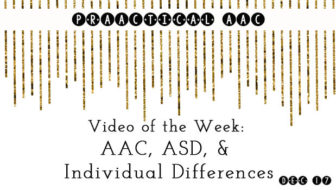
When you’ve worked with one person with autism, the saying goes, you’ve worked with one person with autism. It shouldn’t surprise us, then, that this diversity shows up in research data as well. In this presentation, we hear from Dr. David Trembath, from Griffith University in Australia, explores the individual differences in AAC research and discusses their implications. Many thanks to the Centre for Interdisciplinary Research and Collaboration in Autism (CIRCA) at the University of British Columbia, for making this video available. Direct link to video – https://www.youtube.com/watch?v=TvZ-XH6SLVU
Filed under: Video of the Week
Tagged With: research
December 4, 2017
by Carole Zangari -
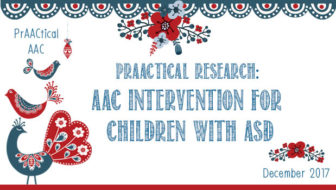
Dr. Kathy Howery is back with another helpful post an AAC research. Kathy is based in Alberta, Canada, and has worked in the field of AT and special education for over three decades. In the past year, she completed her doctoral studies where she used phenomenological methods to seek to understand the lived experience of speaking with/through a speech generating device. Kathy is currently working as a consultant to schools and school districts across Alberta focusing primarily on children and youth with complex communication needs. In this article, she discusses research on AAC interventions. Enjoy! ::::::::::::::::::::::::::::::::::::::::::::::::::::::::::::::::::::::::::::::::::::::::::::: Almirall, D. , DiStefano, C., Chang, Y.-C., Shire, S., Kaiser, A., Lu X, Nahum-Shani, I., Landa, R., Mathy, P. & Kasari, C. (2016). Longitudinal Effects of Adaptive Interventions with a Speech-Generating Device in Minimally Verbal Children with ASD. Journal of Clinical Child & Adolescent Psychology, 45(4), 442-456. What this article is all about (the focus... [Read More...]
Filed under: Featured Posts, PrAACtical Thinking
Tagged With: Kathy Howery, research
December 31, 2014
by Carole Zangari -

“A 21st century clinician who cannot critically read a study is as unprepared as one who cannot take blood pressure or examine the cardiovascular system.” What better way to end one year and usher in the new, than a reminder of the role of scientific study in our profession? In AAC, there isn’t as much research as we would like, but we sure do need to make it our business to evaluate and use the empirical evidence that we do have. P.S. We like Coldplay a little more now. ::::::::::::::::::::::::::::::::::::::::::::: Glasziou, P., Burls, A.,& Gilbert, R. (2008). Evidence based medicine and the medical curriculum: The search engine is now as essential as the stethoscope. The BMJ, 337, 704. Direct Link to Video: https://www.youtube.com/watch?v=QUW0Q8tXVUc
Filed under: PrAACtical Thinking
Tagged With: Coldplay, EBP, evidence, research
December 7, 2014
by Carole Zangari -
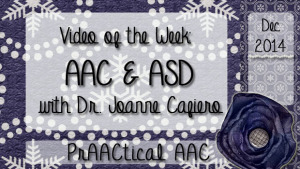
Do you get questions about effective AAC practices for individuals with autism? This video, featuring Dr. Joanne Cafiero, provides a helpful review of some of the issues. Many thanks to AssistiveWare for hosting this video.
Filed under: Video of the Week
Tagged With: ASD, EBP, Joanne Cafiero, research
August 6, 2014
by Carole Zangari -
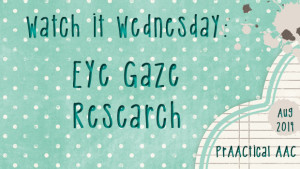
Today, we’ll take a look at a collaborative effort by researchers at University College London (Department of Developmental Science), Great Ormond Street Hospital for Children (Neurodisability Service), and Barnsley Hospital. These researchers are investigating the eye gaze patterns of children with cerebral palsy who have little or no functional speech. Could tracking eye movements be a useful way to assess language skills? This is a line of research we will be watching. Direct Link: http://www.ucl.ac.uk/gaze
Filed under: PrAACtical Thinking
Tagged With: collaboration, eye gaze, research
June 10, 2014
by Carole Zangari -
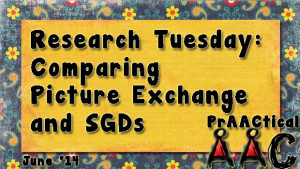
Picture exchange is powerful strategy for building symbolic communication in individuals with significant communication difficulties. We’ve posted about implementation of PECS a few times, and included references to research supporting its efficacy in some additional posts. Today, we look at a sequence of three single subject design experimental studies by Dr. Jeff Sigafoos and other researchers that looked at how the use of picture exchange and AAC devices (SGD condition) impacted social interaction. In the initial study, the team taught requesting skills either with picture exchange or AAC devices and then looked to see if there were any changes in social interaction. They hypothesized that the physical act of picking up a symbol and giving it to someone, as with the picture exchange condition, would make the learner less likely to turn away from his communication partner. So, in addition to measuring how well the participant learned to make requests,... [Read More...]
Filed under: PrAACtical Thinking
Tagged With: Jeff Sigafoos, picture exchange, research, Research Tuesday, SGD
February 20, 2014
by Carole Zangari -
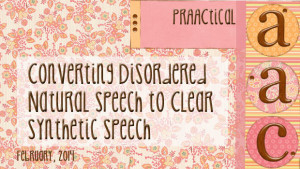
One of the exciting things about being in an AT-related field, is watching new developments in technology. Many of us have worked with individuals who have intact language and severely impaired speech. When we last wrote about ViVoca (Voice-Input, Voice-Output Communication Aid), it generated a lot of interest as a potential support for some individuals who struggle with face-to-face communication. The research efforts are lead by Dr. Mark Hawley, Professor of Health Services Research at the University of Sheffield, in the UK. We’re pleased to be able to share a video showing this emerging technology in aaction. Direct Link: http://www.youtube.com/watch?v=qTyjlM2jYMs
Filed under: PrAACtical Thinking
Tagged With: intelligibility, research, SGD, speech intelligibility, technology, ViviVoca
January 22, 2014
by Carole Zangari -
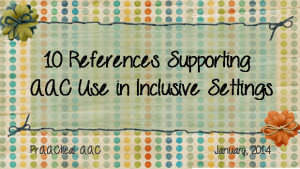
We sometimes get contacted by colleagues who are looking for references supporting the use of AAC. Here are some that are specific to inclusive settings in schools and in the community.* Alquraini, T., & Gut, D. (2012). Critical components of successful inclusion of students with severe disabilities: Literature review. International Journal of Special Education, 27(1), 42-59. Balandin, S., & Duchan, J. (2007). Communication: Access to inclusion. Journal of Intellectual and Developmental Disability, 32(4), 230-232. Batorowicz, B., Mcdougall, S., & Shepherd, T. A. (2006). AAC and community partnerships: The participation path to community inclusion. Augmentative and Alternative Communication, 22(3), 178-195. Calculator, S. (2009). Augmentative and alternative communication (AAC) and inclusive education for students with the most severe disabilities. International Journal of Inclusive Education, 13 (1) 93-113. Carter, M., & Maxwell, K., (1998). Promoting interaction with children using augmentative communication through peer-directed intervention. International Journal of Disability, Development, and Education 45(1) 75-96. Daugherty,... [Read More...]
Filed under: PrAACtical Thinking
Tagged With: community integration, education, inclusion, references, research, schools









